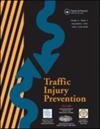韩国酒后驾驶与安全带使用的关系。
IF 1.9
3区 工程技术
Q3 PUBLIC, ENVIRONMENTAL & OCCUPATIONAL HEALTH
引用次数: 0
摘要
目的:尽管在韩国强制使用安全带,其患病率仍然相对较低。本研究通过分析经历过DUIA的人与没有经历过DUIA的人之间安全带使用的流行程度,来检验DUIA(道路交通伤害的主要风险因素)是否可以预测安全带的使用情况。方法:本横断面研究利用了2019年至2021年间进行的韩国国家健康与营养检查调查(KHANES)中9227名20岁或以上的驾驶执照持有人的数据。在调整个人水平协变量后,进行多变量logistic回归分析以调查DUIA经历与安全带使用之间的关系。根据社会人口学变量进行分层分析。最后,进行亚组分析,以检查DUIA经验与安全带使用频率之间的关系,在每个座位类型(驾驶员座位,前排乘客座位和后排座位)。结果:本研究表明,酒后驾车经历与不系安全带显著相关。(aOR, 3.53 [95% CI, 2.55-4.88])。基于社会人口学变量的分层显示,一个人的工作类型(粉红领:aOR, 5.67 [95% CI, 2.03-15.88];蓝领:aOR, 5.35 [95% CI, 3.03-9.47])和吸烟状况(当前吸烟者:aOR, 5.67 [95% CI, 2.72-11.82])增加DUIA经历的患病率。此外,酒后驾车的经历与所有类型的座椅中不系安全带的发生率增加有关。结论:DUIA的患病率可以作为韩国成年人安全带使用的统计显著的独立预测因子。本文章由计算机程序翻译,如有差异,请以英文原文为准。
The association between driving under the influence of alcohol and seatbelt usage in Korea
Objective
Despite the mandatory use of seatbelts in Korea, their prevalence remains comparatively low. This study examines whether DUIA, a leading risk factor for road traffic injuries, predicts seatbelt usage by analyzing the prevalence of seatbelt use among individuals who have experienced DUIA compared to those who have not.
Methods
This cross-sectional study utilized data from 9,227 driver’s license holders aged 20 years or older from the Korea National Health and Nutrition Examination Survey (KHANES) conducted between 2019 and 2021. Multivariable logistic regression analysis was conducted to investigate the association between experience of DUIA and seatbelt use while adjusting for individual-level covariates. A stratified analysis was conducted based on sociodemographic variables. Finally, a subgroup analysis was performed to examine the association between experience of DUIA and frequency of seatbelt use in each seat type (the driver’s seat, the front passenger seat, and the rear seat).
Results
This study showed that having an experience of DUIA is significantly associated with not wearing seatbelts. (aOR, 3.53 [95% CI, 2.55–4.88]). Stratification based on sociodemographic variables showed that one’s job type (pink collar: aOR, 5.67 [95% CI, 2.03–15.88]; blue collar: aOR, 5.35 [95% CI, 3.03–9.47]), and smoking status (current smokers: aOR, 5.67 [95% CI, 2.72–11.82]) increase the prevalence of experience of DUIA. Furthermore, experience of DUIA was associated with an increased prevalence of not wearing seatbelts in all seat types.
Conclusion
The prevalence of experience of DUIA can be established as a statistically significant independent predictor of seatbelt usage among Korean adults.
求助全文
通过发布文献求助,成功后即可免费获取论文全文。
去求助
来源期刊

Traffic Injury Prevention
PUBLIC, ENVIRONMENTAL & OCCUPATIONAL HEALTH-
CiteScore
3.60
自引率
10.00%
发文量
137
审稿时长
3 months
期刊介绍:
The purpose of Traffic Injury Prevention is to bridge the disciplines of medicine, engineering, public health and traffic safety in order to foster the science of traffic injury prevention. The archival journal focuses on research, interventions and evaluations within the areas of traffic safety, crash causation, injury prevention and treatment.
General topics within the journal''s scope are driver behavior, road infrastructure, emerging crash avoidance technologies, crash and injury epidemiology, alcohol and drugs, impact injury biomechanics, vehicle crashworthiness, occupant restraints, pedestrian safety, evaluation of interventions, economic consequences and emergency and clinical care with specific application to traffic injury prevention. The journal includes full length papers, review articles, case studies, brief technical notes and commentaries.
 求助内容:
求助内容: 应助结果提醒方式:
应助结果提醒方式:


